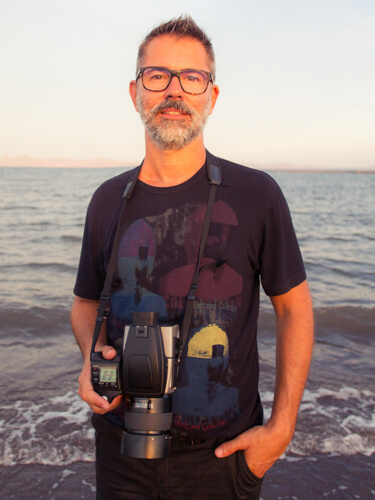Roger Grasas (Barcelona, 1970) begins his professional career as a
photographer in 1998 documenting cooperation projects for national and
international foundations and NGOs as well as for UNESCO. Since then,
traveling becomes the core of his artistic work, translating his experiences
and reflections into visual arts.
Between 2005 and 2009 he is the director of the BisouFoto
communication studio and co-founder of the phototroupe Studio agency. In
both projects he is in charge of the commissions related to travel
photography, editorial portrait and social report. Regular contributor to
several Spanish and international publications.
In 2009 he moves to Riyadh (Saudi Arabia) where he leads the
foundation of the photography department at Imagine Communication, a
high end quality agency for social photography and events. During his stay
in Saudi Arabia and later on until 2016 he develops the project 'Inshallah',
a personal project about the extreme transformation of Middle eastern
societies through the urban contemporary landscape in countries such as
Saudi Arabia, Bahrain, Qatar, Emirates, Oman etc.
His body of work approaches the role and importance that
technology reveals within the post-modern digital society, the state of
strangeness and confusion that human being suffers in the contemporary
landscape and the increasingly connections between art and science.
Sociopolitical issues such as globalization and philosophical concepts such
as the 'difference', 'hyperreality' and 'alienation' generated by the postcapitalist
society and the accelerated implementation of new technologies
are also common places of their work.
Since 1997 he has combined his professional activity with teaching in
photography. Between 1997 and 2004 he teaches Photography and
Landscape Production courses at the UPC's Image and Multimedia
Technology Center. He also works as an academic at the Groc School of
Plastic Arts (Barcelona), at the Communication Faculty of the National
Autonomous University of Mexico and at the Mamori Art Lab Foundation in
Brazil. He has also given various workshops and seminars related to travel
anthropology and contemporary society such as "The Art of Travel:
Photography and Travel" and "Why Travel? Ethics and Aesthetics of Leisure
and Tourism".
His His works have been exhibited on galleries of Spain, France,
Netherlands, Germany, U.S.A., El Salvador, Saudi Arabia and Mexico.
About 'Min Turab'
In the space of a few decades, the landscapes of the Arab Gulf region have undergone a wholesale
mutation driven by increased income from the oil, globalization and mass tourism. These countries have
seen so a huge transformation, moving from the nomadic lifestyle of the bedouin tribes to a hi-tech urban
society. The work takes the title from an arabic expression meaning “from the land”, and is an
observation of this process oscillation between these two poles: an austere, traditional civilization on one
extreme, and a postmodern culture under the powerful influence of capitalism and consumerism on the
other.
Founded on the idea of travel as an artistic method, these photographs hold up a mirror to the dyad of
nature and technology in a place where the old and the new come together and the lines between them
blur. This tension is evident both in the vast desert landscapes and in the images of cities, where the past
and the future are compressed into the close quarters of the present. These representations of the
landscapes of Saudi Arabia, Oman, Bahrain, Kuwait, United Arab Emirates and Qatar throw into sharp
relief the binary opposition of the natural and the constructed. This sense of dislocation feeds into this
idea of travel as an artistic dérive, drifting with no particular destination in mind, in search of new situations
and experiences.
In these dreamlike images, the author reflects on the concepts of the real and the unreal, with viewers left
uncertain as to what is really going on. Almost completely lacking in human presence, these photographs
show the mark left upon the landscape by consumer society at the same time as they seek out the beauty
in strangeness. With a dry wit, the artist focuses his gaze on the idea of the simulacrum. The visual and
conceptual glimpses of this world documents the colonization of contemporary landscapes by technology
and the alienation of human beings in the digital societies of the Arabian Gulf countries. These images of
silent architecture do not offer viewers any conclusions, but rather invite them to reflect and leave the way
clear for a multiplicity of interpretations that connect with viewers' own imaginary.
Selected Books on

